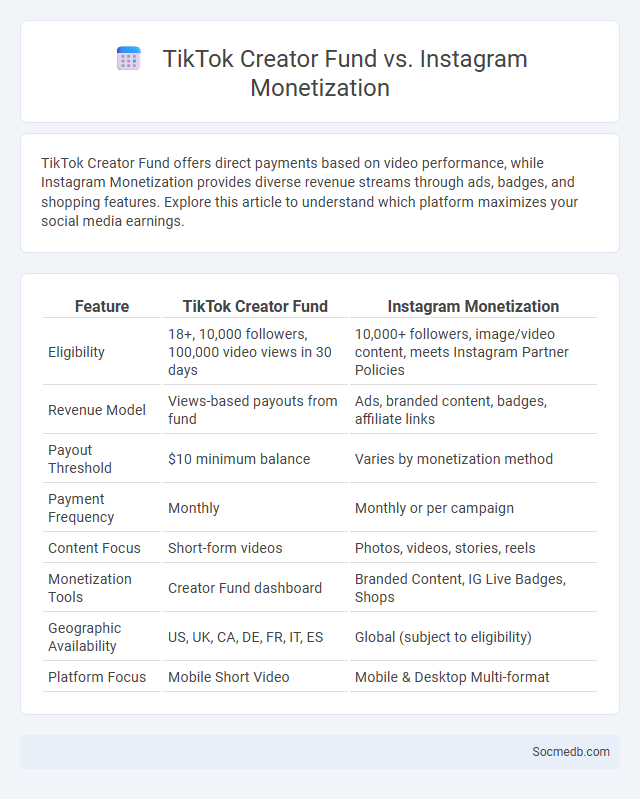
Photo illustration: TikTok Creator Fund vs Instagram Monetization
TikTok Creator Fund offers direct payments based on video performance, while Instagram Monetization provides diverse revenue streams through ads, badges, and shopping features. Explore this article to understand which platform maximizes your social media earnings.
Table of Comparison
| Feature | TikTok Creator Fund | Instagram Monetization |
|---|---|---|
| Eligibility | 18+, 10,000 followers, 100,000 video views in 30 days | 10,000+ followers, image/video content, meets Instagram Partner Policies |
| Revenue Model | Views-based payouts from fund | Ads, branded content, badges, affiliate links |
| Payout Threshold | $10 minimum balance | Varies by monetization method |
| Payment Frequency | Monthly | Monthly or per campaign |
| Content Focus | Short-form videos | Photos, videos, stories, reels |
| Monetization Tools | Creator Fund dashboard | Branded Content, IG Live Badges, Shops |
| Geographic Availability | US, UK, CA, DE, FR, IT, ES | Global (subject to eligibility) |
| Platform Focus | Mobile Short Video | Mobile & Desktop Multi-format |
Introduction to Social Media Monetization
Social media monetization involves leveraging platforms like Instagram, YouTube, and TikTok to generate revenue through ads, brand partnerships, and content subscriptions. Your ability to create engaging content and understand algorithm trends directly impacts your earning potential. Effective strategies optimize reach and audience engagement, turning followers into consistent income sources.
What is the TikTok Creator Fund?
The TikTok Creator Fund is a program designed to reward content creators for their popular videos by paying them based on views and engagement metrics. It aims to support and incentivize creators, helping You grow your audience while earning income directly from your TikTok content. Eligibility requires meeting specific criteria, such as follower count and video views, to join this monetization initiative.
Overview of Instagram Monetization Programs
Instagram offers several monetization programs designed to help creators earn revenue through their content. These include the Instagram Partner Program, Branded Content tools, and in-stream video ads, allowing you to leverage your audience for sponsored posts, affiliate marketing, and ad revenue sharing. Understanding these options can maximize your income potential by aligning your content strategy with Instagram's monetization features.
Understanding Facebook’s Creator Fund
Facebook's Creator Fund supports content creators by providing financial incentives to produce engaging and original videos, boosting platform growth and user interaction. The fund allocates millions of dollars monthly based on video performance metrics such as views, engagement rates, and content originality. This initiative aims to foster a vibrant creator ecosystem, encouraging sustained content production and enhancing audience retention within Facebook's social media environment.
Eligibility Criteria: TikTok vs Instagram vs Facebook
Your eligibility criteria for TikTok, Instagram, and Facebook vary based on age and account requirements: TikTok mandates users to be at least 13 years old with email or phone registration, Instagram requires users to be 13 or older with a valid email or phone number, while Facebook sets the minimum age at 13 but enforces stricter policies for content creators and advertisers. Each platform has specific verification processes to qualify for advanced features, such as live streaming and monetization, with Instagram and Facebook offering more extensive business account options compared to TikTok. Understanding these distinctions ensures you meet the necessary prerequisites to maximize your social media presence effectively.
Payment Structures and Earnings Potential
Social media platforms employ diverse payment structures, including ad revenue sharing, sponsored content partnerships, and subscription models, significantly impacting creators' earnings potential. Influencers and content creators leverage algorithms and audience engagement metrics to maximize income through brand deals, affiliate marketing, and platform-specific monetization tools like TikTok's Creator Fund or YouTube AdSense. Evolving payment models continuously reshape the digital economy, making data analytics and niche targeting crucial for optimizing revenue streams in social media ecosystems.
Application Process Breakdown
Understanding the social media application process breakdown reveals key steps such as account creation, profile optimization, content scheduling, and analytics tracking. You must provide accurate personal information, verify your identity, and agree to platform policies to complete registration successfully. Optimizing each phase enhances user engagement and ensures your social media strategy operates efficiently.
Pros and Cons of Each Monetization Option
Monetizing social media can be achieved through various methods, each with distinct advantages and drawbacks. Sponsored content offers high revenue potential but risks audience trust if overused. Affiliate marketing generates passive income by promoting products, yet success depends heavily on follower engagement and niche relevance. Subscriptions provide steady, predictable income but require consistent, high-quality content creation to justify ongoing payments.
Which Platform is Best for Different Content Creators?
TikTok is ideal for short, engaging videos that appeal to younger audiences and viral trends, while Instagram excels for visual artists, photographers, and lifestyle influencers showcasing high-quality images and Stories. YouTube serves long-form video creators such as educators, vloggers, and entertainers needing in-depth content and monetization options. LinkedIn targets professionals and B2B content creators aiming to build authority through articles, networking, and industry insights.
Future Trends in Social Media Monetization
Social media monetization is evolving with emerging technologies such as augmented reality, NFTs, and AI-driven personalized ads shaping future trends. Influencer collaborations and subscription-based models are becoming primary revenue streams, offering content creators sustainable income. You can leverage these innovations to maximize engagement and optimize your social media earnings.
 socmedb.com
socmedb.com